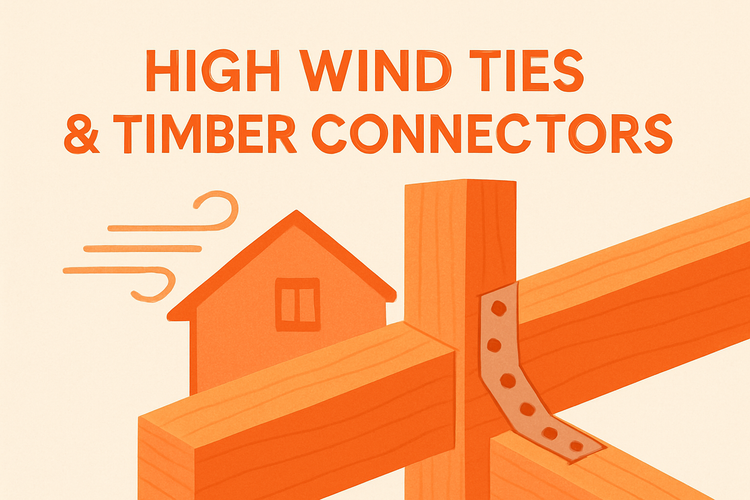Complete Guide To High Wind Ties & Timber Connectors For Timber Projects

The Role of High Wind Ties in Timber Construction
High wind ties are critical components in timber projects, designed to secure structural elements against the destructive forces of strong winds. These connectors help maintain the building's integrity during extreme weather conditions.
In high-wind regions, timber structures are at risk of uplift and lateral pressures caused by gusty environments. High wind ties anchor roof trusses to wall plates or secure posts to bases, effectively reinforcing the entire framework. Choosing the right wind-resistant connectors becomes essential for safety and durability.
These ties vary in range and application, from hurricane ties to tension straps. Advanced models are embedded with corrosion-resistant coatings and are engineered to absorb mechanical stresses with minimal deformation. When combined with other fittings, they contribute to overall stability in load path transfer systems often found in timber-framed buildings.
Integrating high wind ties with joist hangers or post base components magnifies their effect, ensuring a more secure attachment between vertical and horizontal members. This layered approach enhances the building’s resilience from roof to foundation.
Selecting the Right Timber Connectors for Wind Resistance
Choosing the ideal timber connector depends on the application type, design load, and environmental factors. High-performance connectors ensure your timber project not only stands strong during routine use but also remains secured under storm-grade conditions.
High wind connectors are designed for various joinery points such as beam-to-beam, beam-to-post, and roof-to-wall intersections. Selecting connectors rated for uplift and lateral tension is key to meeting wind-load design codes. The dimensions and gauge of the connectors should be compatible with your timber’s dimensions to avoid over-knife effects or splitting.
Look for connectors that conform with international or regional building standards. Products categorized under High Wind ties & timber connectors offer tested solutions for framing applications. These connectors also come with pre-punched holes to align well with approved screws and nails, ensuring reliable installation on-site.
Installation Best Practices for Wind-Resistant Connectors
Proper installation of wind-resistant connectors is as crucial as selecting the right type. Even the most robust hardware will fail if improperly placed or fixed.
Start by consulting architectural or engineering drawings to determine the correct placement of each connector. All fastening should be done using manufacturer-recommended hardware, including corrosion-resistant nails or structural screws. Avoid substituting fasteners, as this compromises the connector’s load-bearing performance. Always inspect the timber condition before installation to eliminate areas of rot or sapwood decay which could undermine resistance.
If you're using post base connectors, ensure they are anchored into structurally sound footing and paired with tension ties when recommended. Marking drilling spots beforehand helps avoid misalignment during fastening. Employing power tools calibrated to avoid over-driving screw heads can also prevent wood damage or fastener slippage.
Perform site-level quality checks post-installation. In certain cases, supplementary ties or restraint straps might be added for redundancy, especially in shear-wind zones. This confirms structural stability over long periods of environmental stress.
Design Integration of High Wind Connectors in Timber Frames
Integrating wind-resistant hardware in timber building design ensures long-term safety and performance. These components should be considered from the early stages of your project plan.
Modern architectural software often includes libraries for various connector categories, helping professionals visualize load transfers and stress points. Ensuring proper integration of joist hangers and uplift-resistant brackets creates a balanced structure from roof to footing. Identifying points vulnerable to wind suction—like open gables and overhangs—guides targeted implementation of ties.
Timber designs that include gable roofs, wide eaves, or tall posts are especially prone to uplift forces. Introducing tension ties and right-angle connectors at diagonal braces and wall joints thus becomes a proactive strategy. Adding these connections in symmetry avoids creating weak lines that could fracture under pressure and promotes force redistribution.
Additionally, incorporating High Wind ties & timber connectors within exterior wall sections ensures stability and compliance with regional codes. Strategic placement ensures structural redundancy, which is vital in storm-prone or exposed coastal settings.
Maintenance and Inspection of High Wind Connectors
Sustained performance of wind connectors depends on routine monitoring. Over time, factors such as corrosion, timber movement, or fungal decay can undermine even the most fortified binders.
Schedule periodic inspections, especially after heavy windstorms, to confirm connection integrity. Look for signs such as rusted fasteners, loosened screws, or warped metal flanges. Using a torque gauge during inspections can reveal internal strain on fittings otherwise not visible. Early detection allows for timely replacements or additional reinforcements, minimizing the chance of catastrophic failure.
Maintenance includes clearing debris around connector zones, treating nearby timber with water-resistant treatments, and retightening or replacing fasteners. Upgrading to stainless steel connectors where damp or saline conditions exist is another preventative measure. This ensures that oxidation and expansion don’t compromise older galvanised steel connections.
Finally, collaborate with engineers if you're unsure about specific wear patterns across aged connectors or supporting joints. Their input ensures that upgrades—like substituting retired brackets with stronger models from High Wind ties & timber connectors—align structurally and aesthetically with your original build.
